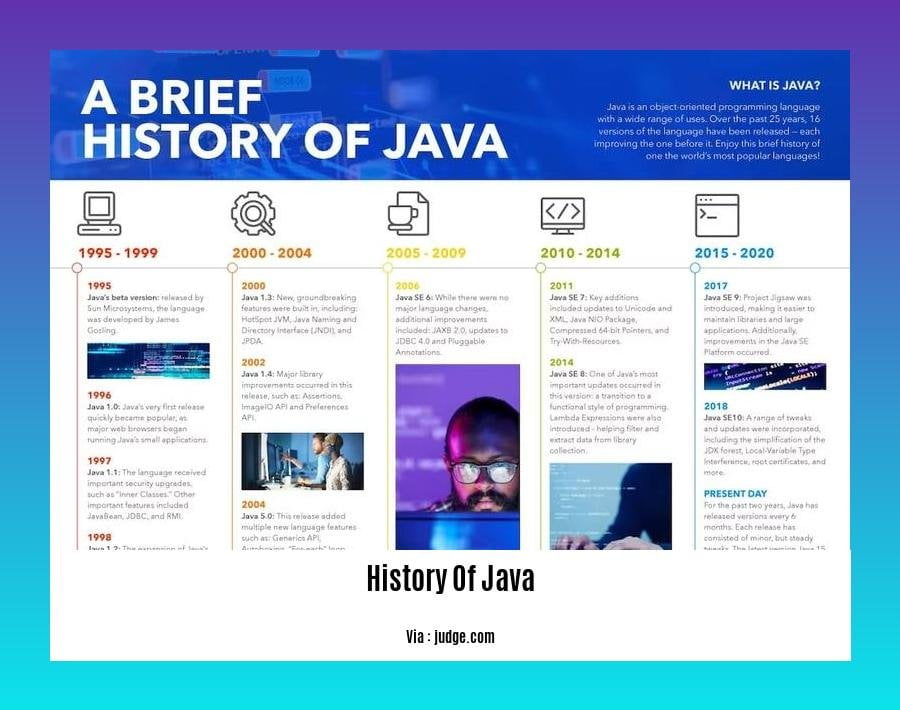Embark on a captivating journey through [- The History of Java: A Journey Through Time]. Delve into the philosophical underpinnings, key milestone releases, and the profound impact Java has had on shaping the world of programming. Experience the evolution of this transformative language as we explore its pivotal role in revolutionizing software development, unlocking the potential for innovation, and connecting individuals worldwide.
Key Takeaways:
- Java is a versatile programming language created in 1991.
- Initially intended for embedded systems, it became popular for web development and applets.
- Java has continuously evolved over time with new features and tools.
- Oracle acquired Java in 2009.
History of Java

In the tapestry of computer science, Java stands as a vibrant thread, its evolution entwined with the rise of the internet and the evolution of software development. As we delve into the history of Java, we’ll trace its remarkable journey from humble beginnings to its position as a global programming powerhouse.
Dawn of Java: 1991
In the early 90s, as the world embraced the promise of the internet, a team led by James Gosling at Sun Microsystems embarked on a mission to create a versatile language for embedded systems. They envisioned a language that could run on any device, providing a uniform platform for developers. That language was Java.
Rise in Web Development
As the web gained traction, Java’s platform-independent nature made it an ideal choice for developing web applications. Its robustness and security features further cemented its popularity. Java applets, embedded into web pages, allowed for dynamic interactivity and enriched user experiences.
Evolution and Adoption
Over the years, Java has undergone continuous evolution, with new versions bringing significant enhancements. From the introduction of Java Servlet API for web development to the Java Virtual Machine (JVM) for performance optimization, Java has adapted to meet the demands of the ever-changing tech landscape.
Java in the Modern Era
Today, Java remains a cornerstone of software development. It’s used extensively in enterprise applications, Android app development, web services, and big data analytics. Its vast ecosystem of libraries and frameworks empowers developers to build complex systems with ease.
Java’s Legacy
The history of Java is a testament to its enduring influence on the world of programming. Its platform-independence, robust design, and unwavering commitment to innovation have made it the language of choice for developers worldwide. Java continues to stand as a symbol of progress, innovation, and the transformative power of technology.
For an in-depth exploration of the Java programming language development, immerse yourself in this comprehensive article that delves into its evolution and impact on contemporary software development practices.
Uncover the impact on internet applications in this illuminating read, where you’ll discover how Java has revolutionized the way we interact with the digital realm.
Embark on a journey through the Java platform evolution, witnessing firsthand the pivotal milestones that have shaped the trajectory of this groundbreaking technology and its enduring influence on the tech landscape.
Importance of Java

Java, a widely adopted programming language, has significantly impacted software development due to its versatility, cross-platform compatibility, and robust design. Here’s why Java holds such high importance in the tech landscape:
Key Features of Java
- Object-Oriented: Java’s object-oriented principles promote code reusability, maintainability, and extensibility.
- Platform Independent: Thanks to the Java Virtual Machine (JVM), Java code can run seamlessly on different operating systems without recompilation.
- Secure and Reliable: Java’s strict type-checking, memory management, and exception handling ensure code stability and reduce security vulnerabilities.
Use Cases of Java
- Enterprise Applications: Java’s scalability and robustness make it ideal for developing large-scale enterprise systems in finance, healthcare, and e-commerce.
- Mobile Applications: With the Android platform built on Java, it’s extensively used in mobile app development, accounting for a significant share of the market.
- Web Development: Java frameworks like Spring and JSF facilitate the creation of dynamic and user-friendly web applications.
- Big Data and Analytics: Java’s libraries, such as Hadoop and Spark, empower developers to handle and process vast amounts of data effectively.
Impact of Java
Java’s widespread adoption has had profound implications for the software industry:
- Accelerated Development: Java’s “write once, run anywhere” approach enables developers to create applications that can be deployed on multiple platforms, reducing development time and costs.
- Technical Innovation: Java’s open-source nature and extensive ecosystem of libraries and frameworks foster innovation and collaboration.
- Skilled Workforce: Java’s popularity has led to a large pool of skilled Java developers, making it easier for businesses to find and hire talent.
Key Takeaways:
- Java’s object-oriented design, platform independence, and robust features make it a versatile and reliable programming language.
- Java finds applications in diverse domains, including enterprise systems, mobile development, web development, and big data.
- Java’s impact on the software industry has been significant, accelerating development, fostering innovation, and empowering businesses.
Sources:
FAQ
Q1: What is the philosophy behind Java’s design?
A1: Java’s design emphasizes portability, object-orientation, security, and robustness, known as the “WORA” principles (Write Once, Run Anywhere).
Q2: What have been the major milestones in Java’s version history?
A2: Key milestones include the release of Java 1.0 in 1996, Java 2 Standard Edition (J2SE) in 1999, and Java 8 in 2014, introducing significant new features and enhancements.
Q3: Why is Java considered an important programming language?
A3: Java is widely used for developing a wide range of applications due to its platform independence, object-oriented nature, scalability, and extensive library support.
Q4: How has Java evolved over time?
A4: Java has undergone significant evolution since its inception, with the addition of new features, libraries, and tools, as well as improvements in performance and security.
Q5: What are some of the key benefits and applications of Java?
A5: Java offers advantages such as portability, scalability, object-orientation, and robust security. It is widely used in developing web applications, mobile apps, enterprise systems, and various industry domains.
- Star Ring Trends: Etsy vs Amazon - March 28, 2025
- Boost Pollinator Habitats: Baby Blue Eyes Sustainable Farming Guide - March 28, 2025
- Protect Big Black Bears: Effective Conservation Strategies - March 28, 2025
















